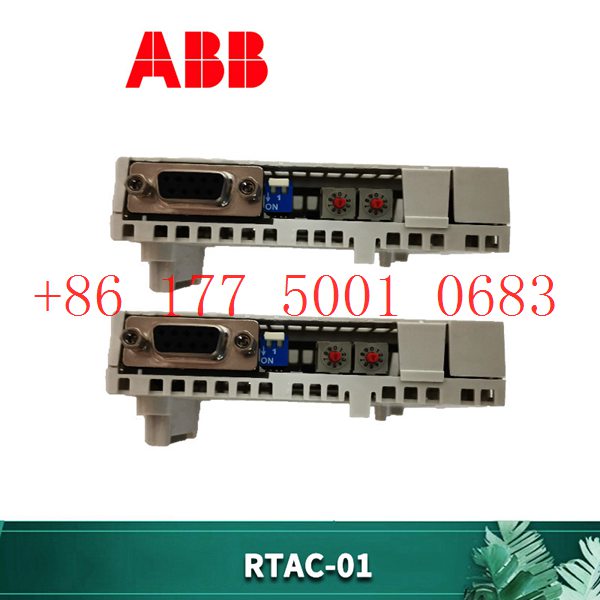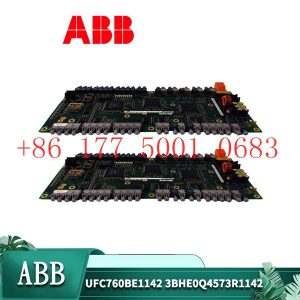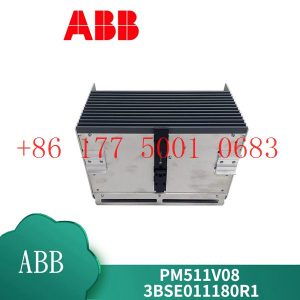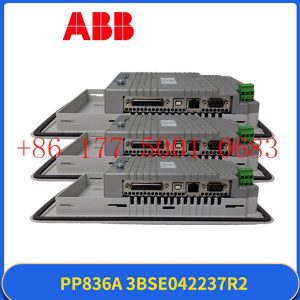Description
hardware flow control. It is an ideal choice in the field of industrial automation.
Implementation of communication between ABC industrial robot and PLC based on DeviceNet fieldbus technology
introduction
In modern production systems, industrial robots and PLCs need to communicate and collaborate to complete production tasks. That is, the
industrial robots output signals to the PLC, allowing the PLC to control related equipment to drive the robot”s front-end tools. This article
mainly analyzes the communication problems between ABB industrial robots and PLC based on DeviceNet fieldbus technology.
DeviceNet is a common network communication method in the field of automation. ABB industrial robots establish a network to communicate with
Siemens PLC based on the DeviceNet network.
1Configure DSQC652
There are mainly 5 types of standard I/0 boards commonly used in ABB industrial robots [2]. Except for the different addresses assigned to
them during setup, their configuration methods are basically the same. This article mainly analyzes the ABB standard I/0 board DS0C652, which
mainly builds communication modules based on the DeviceNet network. The DS0C652 board has a distributed I/O module with 16 digital input and 16
digital output interfaces. The board is installed in the ABB industrial robot control cabinet. First, define the specific operation steps of the DS0C652 board,
enter the teach pendant control panel, then enter the configuration menu (Figure 1), select the DeviceNetDevice menu, and add a template to enter Figure 2.
ABB standard I/0 board is hung on the DeviceNet
network, so the address of the module in the network must be set. The jumpers 6 to 12 of terminal x5 are used to determine the address of the module.
The available address range is 10 to 63. Modify the parameters in the template parameters to complete the DS0C652 board settings. Click the drop-down
menu to select the “Use value from template” row, select
“DS0C65224VDCI/0Device”, and then the parameters that need to be set include the address of the I/0 board in the bus.
Figure 1 Configuring DSQC652
2Configure signals and parameters
After completing the DS0C652 board setting, the I/0 signal setting will be performed. Setting the I/0 signal is the basis for establishing communication with
the PLC. The PLC communicates and transmits data with the ABB industrial robot through the I/0 signal and the DS0C652 board. As shown in Figure 3, in the
signal configuration interface, there are many default I/0 points after the system is established. Modification is not allowed. Click “Add” to add signals. When setting
input and output signals, their address range is 0~15. First, enter the signal menu in the configuration options to set the input and output types, and modify the corresponding parameters.
After completing the settings, the computer prompts that you need to restart the settings. If there are multiple signals that need to be defined and the waiting time
is long after restarting multiple times, you can click “Cancel” and wait for all signals to be defined before clicking the “Yes” button to restart. After the signal settings are
completed, click to select “Input and Output” in the ABB menu to check whether all signals have been set.
Figure 2 Configure DSQC652 parameters
Figure 3 Signal parameter settings
During the signal establishment process, attention should be paid to the DSoC652 port and PLC port addresses used, and the corresponding address table should be
established, as shown in Table 1. The robot interacts with the PLC through I/O signals. During the setting process, there must be no errors in the port and address number
of the PLC connected to the DSoC652. If the address is set incorrectly, the communication between the robot and the PLC will not work properly.
The entire robot teaching pendant setting process is shown in Figure 4.
https://www.xmamazon.com
https://www.xmamazon.com
https://www.plcdcs.com/
www.module-plc.com/
https://www.ymgk.com
5SHX1445H0001 5SXE05-0152 ABB
5SHX1445H0001 3BHB003230R0101 ABB
5SHX1445H0001 3BHL000391P0101 3BHB003230R0101
5SHX1445H0001 3BHL000391P0101 ABB
5SXE05-0152 IGCT module ABB
3BHB003230R0101 IGCT module ABB
3BHL000391P0101 IGCT module ABB
5SHX1445H0001 IGCT module ABB
3BHL000387P0101 IGCT module ABB
5SHX1445H0002 IGCT module ABB
5SHX1445H0002 3BHL000387P0101 ABB
5SHX14H4502 3BHB003230R0101 5SXE05-0152 3BHB003023P201AEND:B
5SHX14H4502 3BHB003230R0101 5SXE05-0152
5SHX14H4502 5SXE05-0152 ABB
5SHX14H4502 3BHB003023P201AEND:B
5SHX14H4502 3BHB003230R0101 ABB
3BHB003023P201 AEND:B IGCT module
3BHB003230R0101 IGCT module ABB
5SHX14H4502 IGCT module ABB
3BHL000390P0104 IGCT module ABB
5SHX1960L0004 IGCT module ABB
5SHX1960L0004 3BHL000390P0104 ABB
5SHX2645L0004 5SXE04-0150 GVC707AE01
5SHX2645L0004 3BHB003154R0101 ABB
5SHX2645L0004 3BHL000389P0104 3BHB003154R0101
5SHX2645L0004 3BHL000389P0104 ABB
5SXE04-0150 GVC707AE01 ABB
3BHB003154R0101 IGCT module ABB
3BHL000389P0104 IGCT module ABB
5SHX2645L0004 IGCT module ABB
336A4954ARP1 IGCT module ABB
5SHY3545L0003 IGCT module ABB
5SHY3545L0003 336A4954ARP1 ABB
5SHY3545L0005 336A4954ARP2 ABB
336A4954ARP2 IGCT module ABB
5SHY3545L0005 IGCT module ABB
GVC750BE101 IGCT module ABB
3BHE009681R0101 IGCT module ABB
3BHB013085R0001 IGCT module ABB
5SHY3545L0009 IGCT module ABB
5SHY3545L0009 GVC750BE101 ABB
5SHY3545L0009 3BHE009681R0101 ABB
5SHY3545L0009 3BHB013085R0001 ABB
5SHY3545L0009 3BHB013085R0001 3BHE009681R0101
5SHY3545L0009 3BHB013085R0001 3BHE009681R0101 GVC750BE101
5SHY3545L0010 GVC750BE101 ABB
5SHY3545L0010 3BHE009681R0101 ABB
5SHY3545L0010 3BHE009681R0101 GVC750BE101
5SHY3545L0010 3BHB013088R0001 3BHE009681R0101 GVC750BE101







Reviews
There are no reviews yet.